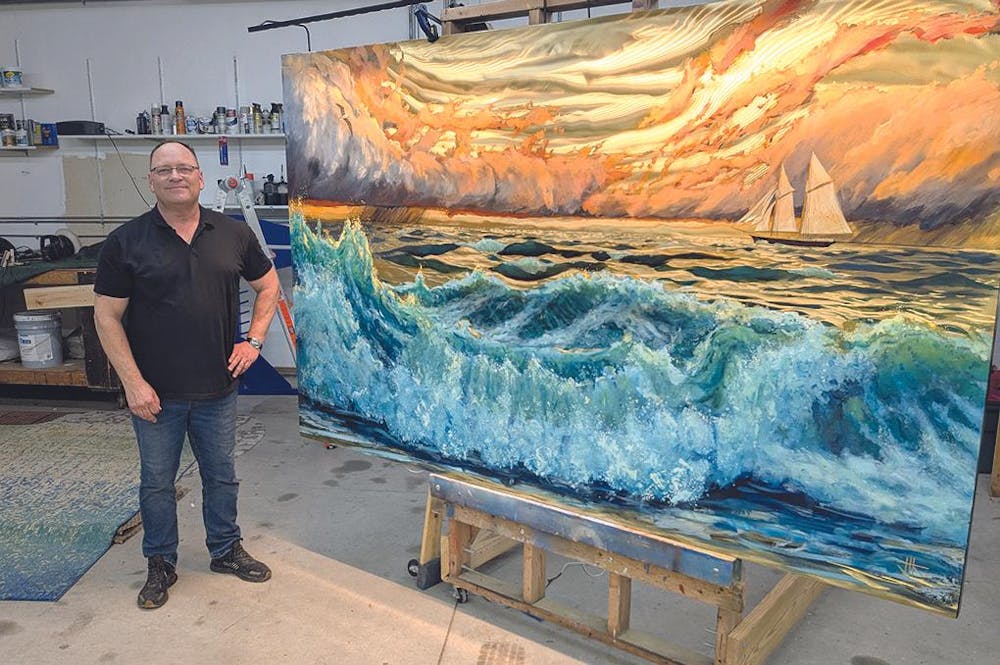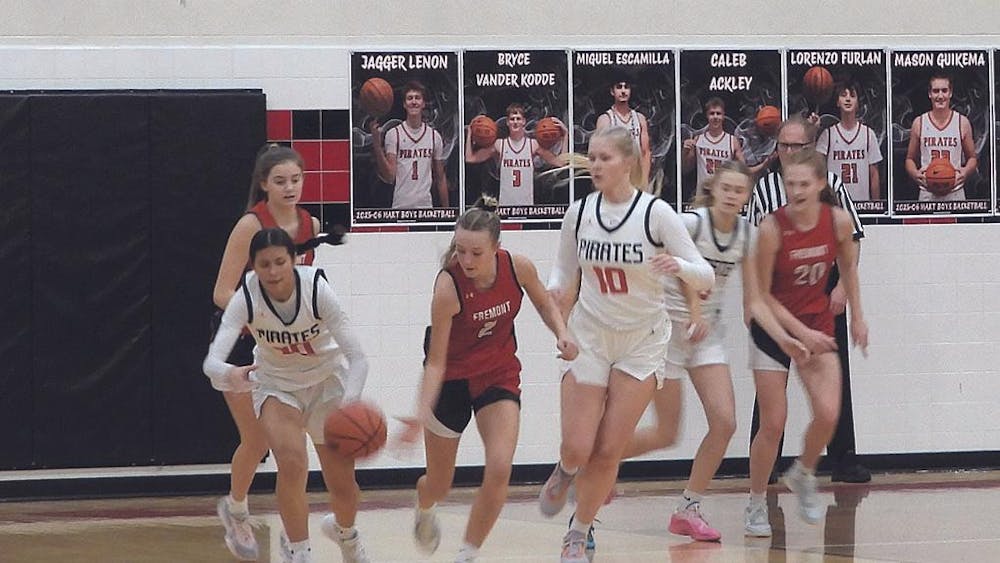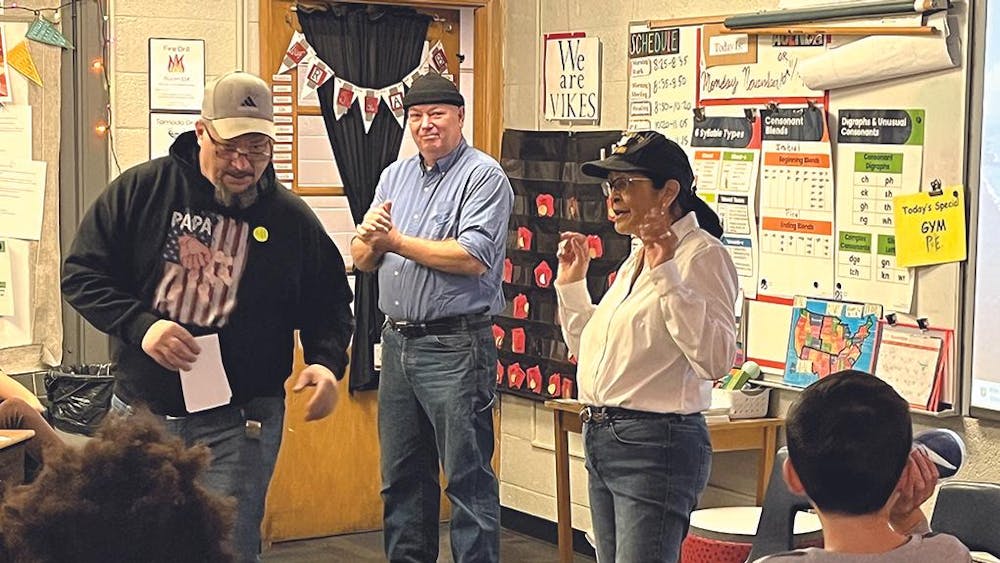MONTAGUE — New Montague resident John Katerberg grew up having artistic talent. He still has a clay elephant he made in third grade, and to this day he's surprised at how well it turned out.
Katerberg has graduated far beyond clay now; he uses a rare technique that involves painting and brass, which creates a wow-worthy effect. It's an effect that helped make his painting, Dynamic Sunset, the $125,000 grand prize winner at ArtPrize in Grand Rapids last fall; it later sold for $20,000.
That painting, an 8-foot by 5-foot work, spotlighted a Lake Michigan lighthouse modeled after the ones Katerberg visited in Grand Haven when growing up in Jenison. This year, in recognition of his 2024 win, ArtPrize invited him back to display a new painting for this year's festival, which began Thursday and lasts through Oct. 4. This one, which he said took him two months to complete, is the same size and is another Lake Michigan scene, but it pays tribute to his new hometown by depicting the Ella Ellenwood, the famed schooner that sank in Lake Michigan in 1901. The craft is memorialized in the sculpture atop the Montague weathervane, and Katerberg painted it sailing in the background.
"We moved up here in May, and I saw the weathervane," Katerberg said. "I looked at different buildings and the schooners out there, and it felt like this was important to this community. I needed to do a painting.
"It's a bit of history. I think in the back of people's minds, when they think of Michigan and see the lighthouses and know about the logging history, it has a historic connection."
As preparation for including the Ella Ellenwood in his painting, Katerberg said he visited the Montague Museum and spoke with a historian there, did research on the schooner, and flew his drone to the top of the weathervane sculpture to get a closer look at it.
Katerberg is a retired veteran, having served in Operation Desert Storm in Iraq and Operation Enduring Freedom in Afghanistan. A mechanic during his service, he received a Purple Heart when he suffered career-ending injuries from running over an improvised explosive device (IED) in Afghanistan.
With his military time over, Katerberg set his sights on his first love and completed his degree from Kendall College of Art and Design in Grand Rapids. Later, he learned the art of using brass in paintings from a cousin, fellow artist Amanda Clark, which also gave him the opportunity to apply the metal work skills he honed during his service.
"She did more abstract (work), and I added in a little bit of realism," Katerberg said. "(My work) doesn't really look real, per se, but it has what I call an animating effect. As you move around the painting, the grind marks and the brass change the painting, and it makes that abstract combine in your brain with the more real stuff. I think I'm the only one in the world doing that combination."
The technique requires more than painting, though that's the most obvious skill he employs. Katerberg uses a TIG welder to make an aluminum frame for his works, and he purchases backing material to attach the brass to a sturdy surface. These are all things that have gotten much easier, he said, since winning at ArtPrize gave him the funds to purchase more and better supplies.
It's a very intensive process, as you might imagine. Katerberg has begun taking interested observers through the process by posting videos to YouTube and TikTok under the account WarriorArtist2024.
Another step in the process of creating these works that isn't part of your everyday painting is clear-coating, which bears resemblance to the work done to make cars' paint weather-resistant. As a result of that work, Katerberg's paintings can be touched without damaging them, and unless they are left in sunlight for long periods, they will retain their grand appearances.
The clear-coating has the added effect of, slightly but noticeably, changing some colors in the painting. Katerberg said the Ella Ellenwood he painted in his new work had sails that were whiter than what was in the finished product. However, the somewhat faded look of the sails that came about after the clear-coating was complete added what he called "a historic quality" to the painting and is an example of what artists call "happy accidents."
"They'll say 'D'oh...Wait a minute, that looks better,'" Katerberg said of the accidents. "That kind of happened with this one...It almost gives it the effect of a watercolor because things become more transparent."


The brass technique is best suited to paintings that showcase water, Katerberg said, because of the way it can create the effect of light reflecting off of it, though he recently also painted an image depicting an eagle flying in front of an American flag using the technique. However, it's not merely for utilitarian purposes that he's honed in on paintings of aquatic scenes as his main calling card.
"Back when I was deployed, I would think of Michigan and our lakes and just how refreshing it is, and that would help me mentally check out of a nasty place (and come) back here," Katerberg said. "That's one reason I just love lakes."
Katerberg is now in Montague in part to be closer to family; he and wife Barbra have a daughter and son-in-law who live in Claybanks and another daughter and son-in-law who will soon be moving to North Muskegon, and both couples are farmers. He said he and Barbra searched for months for a suitable home in the area and had little luck at first, mainly because, as he put it, he was in search of "a studio (that) has a house." They basically gave up at one point before ultimately finding what they were looking for.
His workshop is big enough that it has an adjoining room that he plans to turn into a small fine art gallery in hopes of getting "on the route" of similar galleries in the West Michigan area. No doubt his own work will be part of what's on display, as he continues to produce works the likes of which very few attempt.
"Artists are always looking for their unique voice, and this is mine," Katerberg smiled.













